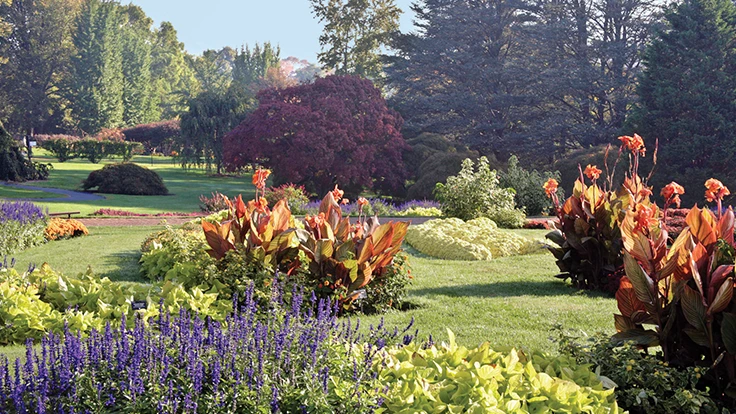

Hardy species, edibles, new colors, variegated foliage and support of the environment are just a few planting possibilities to look for as the spring growing season commences in earnest. To maintain their busy schedules, gardeners are also leaning toward low-maintenance care of their landscapes in 2019.
Alyssa Hagarman, a horticulture specialist at Hershey Gardens in Hershey, Pennsylvania, points to a surge in perennials and heirlooms this season for people not interested in replanting every year. While not native to North America, one species making the rounds regionally is Actaea simplex, or bugbane, a shade-tolerant perennial bearing late-season spikes of creamy white flowers on tall stems. Easy-care bugbane is a resilient addition to beds, cottage gardens, borders and naturalized areas, Hagarman says.
Meanwhile, Amsonia tabernaemontana — also known as bluestar — is a native perennial with dense clusters of pale blue spring flowers and golden fall foliage.
“Bluestar turns a brilliant yellow in autumn, so you’re going to get three seasons out of it,” Hagarman says.
This year’s annuals are “easy keepers,” too: standbys such as begonias, marigolds, zinnias and the vinca genus of flowering plants are all good bloomers and simple to care for, requiring no pruning as they fade out of bloom.
What can your plant do for you?
Maria Zampini, president of the horticulture marketing firm UpShoot, says gardening trend-watchers are probably asking themselves now the same question they do every year: “What problem will this plant solve for me?” Happily, that query has multiple answers, including disease- and pest-resistant plants your typical home gardener doesn’t have to spray with chemicals.
Impatiens work well in a garden, particularly when planted in a single color, Zampini says. With downy mildew affecting many impatiens, though, growers have had to diversify their offerings with begonias, fuchsias and coleus. But now, a new series of Impatiens walleriana is protected from the disease.
“People want something tough as nails so they don’t have to spend money on chemicals,” Zampini says. “And if they have a plant that deadheads on its own, they’re happy because they can spend more time on their kayak in the summertime.”
Whether it’s annuals, perennials or any native plant, more people are growing pollinator gardens with an eye toward a healthy environment. Joe Pye Weed (Eupatorium purpureum), for example, grows in full sun or light shade in late summer, carrying large round heads of rosy pink flowers. Rising to a height of four to seven feet, the attractive plants entice pollinating birds and insects during the peak of the season.
“Butterflies and hummingbirds love them,” Hagarman says. “There are also some dwarf varieties coming out that would fit the garden of a general homeowner.”
As the National Pollinator Garden Network (NPGN) recently surpassed its goal of one million registered pollinator gardens, it’s evident that ordinary citizens are motivated to do their part for the planet, Zampini adds.
“It’s a feel-good story for sure,” she says. “It’s not just growing a plant that makes them feel good, they’re supporting nature as well.”
The environment’s renewed spot in the public consciousness has inspired growers to mix edibles into the landscape rather than cultivating them in separate food gardens, says Jody Davey, an indoor horticulture and programs specialist at Hershey Gardens.
Fruits, vegetables and herbs have made a comeback in the last decade, but Davey says gardeners who don’t want edibles taking over their plots are placing dwarf tomatoes and cucumbers in beds or along borders and walkways.
Bringing blueberries and raspberries into the garden is another popular trend in the burgeoning art of “foodscaping,” Zampini says.
“People are using their backyard as an outdoor living room or entertainment area, so you have more of these items making their way closer to the home,” she says. “There doesn’t have to be that second designated area.”

Looking beyond the flower
Tropical plants, including elephant ears and colorful canna lilies, are being incorporated into home landscapes, serving as a low-maintenance eye-catcher in the center of a conventional flower bed.
“Just one elephant ear grows so fast and big, people are going to be drawn to that, then you can grow more traditional plants around it,” Davey says. “It’s something that adds a little punch to the landscape.”
Zampini suggests finding plants that match Living Coral, named in January as Pantone’s 2019 Color of the Year. Certain types of roses, begonias, coneflowers and early-blooming tulips exhibit this vibrant yet mellow shade, while those yearning for variegated foliage can turn to a genus of coleus featuring a pink center and green edging.
Indeed, more growers are looking at attributes beyond the flower as 2019 rolls on. Diane Blazek, executive director of All-America Selections and the National Garden Bureau, says bicolored and tricolored plants exploded onto the scene about six years ago, and show no signs their popularity is waning.
“There are purples, greens, and spots and dots,” Blazek says. “Hostas with color variations are all about the foliage.”
Ultimately, keeping apprised of new trends is critical for greenhouse growers aiming to sell their wares to landscapers, Davey says.
“I would think growers would want to produce product that will sell and sell very well,” she says. “Following trends and growing to them ensures their crops are popular in markets that landscapers ultimately cater to, whether residential or commercial.”

Explore the April 2019 Issue
Check out more from this issue and find your next story to read.
Latest from Greenhouse Management
- California Spring Trials 2026 dates announced
- Les Evans promoted to DRAMMwater segment manager, Al Zylstra to retire
- Hoffmann Family of Companies to acquire N.G. Heimos Greenhouses
- GIE Media Horticulture Group wins five regional 2025 Azbee Awards of Excellence
- Grant awarded to test western U.S. wood species for use as wood fiber potting substrate
- Pennsylvania Horticultural Society announces 2025 Gold Medal Plant winners
- Oasis Grower Solutions announces new Southeast territory sales manager
- How to reduce labor in greenhouse vegetable production







